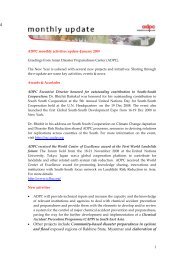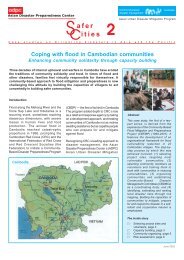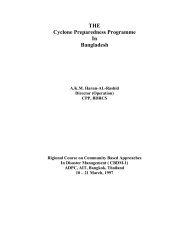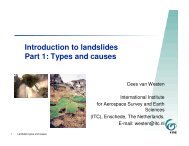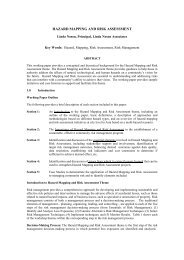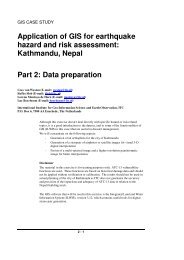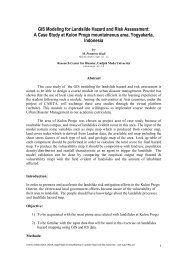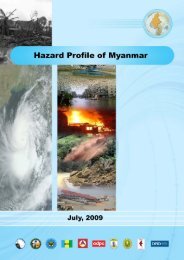community-based disaster risk management and the media media kit
community-based disaster risk management and the media media kit
community-based disaster risk management and the media media kit
You also want an ePaper? Increase the reach of your titles
YUMPU automatically turns print PDFs into web optimized ePapers that Google loves.
chapter 2. <strong>media</strong> <strong>and</strong> <strong>disaster</strong> <strong>risk</strong> <strong>management</strong><br />
are developed <strong>and</strong> implemented with <strong>the</strong> active participation of all<br />
stakeholders, particularly <strong>the</strong> benefi ciaries/ communities.<br />
3. Encourage survivor participation in recovery: It is imperative<br />
that <strong>the</strong> opinions of survivors are considered in <strong>the</strong> development<br />
<strong>and</strong> implementation of recovery strategies. However, under <strong>the</strong> high<br />
pressure imposed to rebuild infrastructure as soon as possible, <strong>the</strong><br />
authorities <strong>and</strong> o<strong>the</strong>r aid organizations may overlook this aspect.<br />
The <strong>media</strong> can encourage <strong>the</strong> participation of survivors. The <strong>media</strong><br />
can also conduct opinion polls among <strong>disaster</strong> survivors, <strong>and</strong> solicit<br />
<strong>the</strong> people’s opinion on how recovery plans can be made more<br />
relevant to <strong>the</strong> needs of <strong>the</strong> <strong>community</strong>.<br />
4. Infl uence for integrating <strong>risk</strong> reduction <strong>and</strong> prevention: The<br />
process of rehabilitation <strong>and</strong> reconstruction provides a golden<br />
opportunity to integrate <strong>risk</strong> reduction considerations in rebuilding<br />
infrastructure to ensure that it is safer from future <strong>disaster</strong>s. The<br />
<strong>media</strong> can contribute to sustainable social development by providing<br />
relevant information which will highlight, promote <strong>and</strong> advocate<br />
<strong>the</strong> need for <strong>the</strong> integration of <strong>risk</strong> reduction considerations into<br />
rehabilitation <strong>and</strong> reconstruction.<br />
Media Strategies<br />
In order to perform <strong>the</strong> above-mentioned tasks, <strong>the</strong> <strong>media</strong> can follow<br />
different approaches. Some of <strong>the</strong>m include <strong>the</strong> following.<br />
• Organizing expert dialogues: Dialogue among experts on <strong>the</strong><br />
causes of <strong>disaster</strong>s, <strong>risk</strong>s, <strong>and</strong> vulnerabilities <strong>and</strong> on <strong>the</strong> identifi cation<br />
of appropriate solutions would play an important role in facilitating<br />
communication among stakeholders on <strong>disaster</strong> problems <strong>and</strong> also<br />
in raising people’s awareness. Therefore <strong>the</strong> <strong>media</strong> must consider<br />
holding forums among representatives of scientifi c organizations,<br />
e.g. meteorological department, National Disaster Management<br />
Offi ce (NDMO), Mekong River Commission committee, UNDP,<br />
WFP, FAO, Red Cross, etc.<br />
• Public auditing: The <strong>media</strong> can conduct surveys <strong>and</strong> opinion<br />
polls to rate <strong>the</strong> relevance, quality <strong>and</strong> quantity of <strong>the</strong> relief <strong>and</strong><br />
rehabilitation assistance.<br />
29



